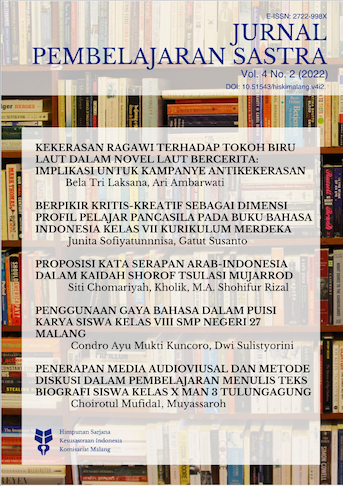PENGGUNAAN GAYA BAHASA DALAM PUISI KARYA SISWA KELAS VIII SMP NEGERI 27 MALANG
##plugins.themes.academic_pro.article.main##
Abstract
Poetry is one of the standards for junior high school (SMP) students' literary abilities. In poetry, there is definitely a language style that functions to beautify the language in poetry. Likewise with poems written by class VIII A students at SMPN 27 Malang. Based on this, the aim of this research is to reveal the use of language styles in students' poetry, so that the types and forms of use of language styles are known and students' abilities in applying diction in poetry. The research used is qualitative. The data sources contained in this research are 34 poems written by students. From the results of the analysis, it was found that sixteen (16) types of language styles were obtained, with a total of 79. The language styles found include: the first is rhetorical reticence with the highest number of occurrences of around 22 data, then followed by the metaphor, hyperbole and personification language styles with 9 data, followed by the anaphora language style with 6 data. There are other language styles such as rhetorical questions and associations with 4 data each, followed by synecdoche pars pro toto and repetition with 3 data. Next there are the language styles of allegory, tautology, synecdoche totem pro parte which both amount to 2 data, then there are also the language styles of epic parable, simile, pleonasm, and alliteration which each have 1 data. The forms of language style units obtained from students' poetry are in the form of word units, sound units and sentence units. Finally, students' ability to apply denotative and connotative meaningful diction in poetry.
##plugins.themes.academic_pro.article.details##

This work is licensed under a Creative Commons Attribution-NonCommercial-NoDerivatives 4.0 International License.
The Authors submitting a manuscript do so on the understanding that if accepted for publication, copyright of the article shall be assigned to Jurnal Pembelajaran Sastra (Journal of Literary Education) as publisher of the journal, and the author also holds the copyright without restriction.
Copyright encompasses exclusive rights to reproduce and deliver the article in all form and media, including reprints, photographs, microfilms and any other similar reproductions, as well as translations. The reproduction of any part of this journal, its storage in databases and its transmission by any form or media, such as electronic, electrostatic and mechanical copies, photocopies, recordings, magnetic media, etc. , are allowed with a written permission from Jurnal Pembelajaran Sastra (Journal of Literary Education).
Jurnal Pembelajaran Sastra (Journal of Literary Education), the Editors and the Advisory International Editorial Board make every effort to ensure that no wrong or misleading data, opinions or statements be published in the journal. In any way, the contents of the articles and advertisements published in the Jurnal Pembelajaran Sastra (Journal of Literary Education) are sole and exclusive responsibility of their respective authors and advertisers.
References
Anggreni, Shella. (2013). Analisis deskriptif tentang struktur fisik puisi karya siswa di kelas vb sd negeri 2 kota bengkulu tahun pelajaran 2012/2013. Skripsi). Pendidikan Guru Sekolah Dasar, Universitas Bengkulu.Azwar, Saifudin. 2007. Metode Penelitian. Yogyakarta: Pustaka Pelajar.
Arsad, A. (2019). ANALISIS PENGGUNAAN GAYA BAHASA DALAM PUISI KARYA SISWA KELAS VII SMP NEGERI 1 PASARWAJO. JEC (Jurnal Edukasi Cendekia), 3(2), 18-23.
Astuti, R. (2013). Karakteristik Gaya Bahasa dalam Puisi Karya Siswa Kelas SMP Negeri 14 Yogyakarta. Skripsi SL Diunduh dari Http://www. eprints. uny. ac. id pada, 2.
Ati, S., & Soamangun, S. F. (2023). Analisis Penggunaan Gaya Bahasa pada Puisi Karya Siswa Kelas VII SMP Negeri 1 Sanana. Jurnal Ilmiah Wahana Pendidikan, 9(8), 785-791.
IFTITA, A. D. (2021). PENGGUNAAN GAYA BAHASA PUISI KARYA SISWA KELAS X IPS 2 SMAN 1 REJOTANGAN TAHUN AJARAN 2020/2021.
Gorys Keraf, D. (2009). Diksi dan gaya bahasa. Gramedia Pustaka Utama.
Kosasih, E. (2012). Dasar-dasar Keterampilan Bersastra. Bandung: CV Yrama Widya.
Kusumawati, E., & Suwignyo, H. (2012). Karakteristik Puisi Karya Siswa Kelas VIII SMP Negeri 8 Malang. Skripsi tidak diterbitkan: Universitas Negeri Malang.
Lafamane, F. (2020). Karya sastra (puisi, prosa, drama).
Moleong, Lexy J. (2006). Metodologi Penelitian Kualitatif. Bandung: PT Remaja Rosdakarya.
---------------------. (2007). Metodologi Penelitian Kualitatif. Edisi Revisi. Bandung: PT Remaja Rosdakarya.
Nafinuddin, S. (2020). Majas (Majas perbandingan, majas pertentangan, majas perulangan, majas pertautan).
Nasional, K. P. (2010). Universitas Negeri Malang. Pedoman penulisan karya ilmiah. Edisi ke lima.
Nirwana, N. (2018). KEMAMPUAN MENGGUNAKAN GAYA BAHASA DALAM MENULIS PUISI SISWA KELAS VIII SMPN 3 LAMASI KABUPATEN LUWU. Jurnal Onoma: Pendidikan, Bahasa, dan Sastra, 2(1).
Pradopo, R. D. (2002). Pengkajian Puisi (Analisis Strata Norma dan Analisis Struktural dan Semiotik). Yogyakarta: Gajah Mada University Press.
--------------------. (2017). Pengkajian Puisi. Yogyakarta: Gadjah Mada University Perss.
--------------------. (2020). Stilistika. Yogyakarta: Gadjah Mada University Perss.
Rahmawati, F. D. (2020). Pedoman Umum Ejaan Bahasa Indonesia PUEBI dan Pembentukan Istilah. Jakarta.: Edu Penguin
Setiyaningsih, I. (2019). Gaya Bahasa dan Aplikasinya (Edisi Tahun 2019). Yogyakarta: PT Penerbit Intan Perwira.
Tarigan, H. G. (2013). Menulis sebagai suatu keterampilan berbahasa. Bandung: Angkasa.
Warsono dan Hariyanto. (2017). Pembelajaran Aktif. Bandung: PT. Remaja Rosdakarya.
Yulsafli, Y., & Karmila, E. (2017). Analisis Diksi dalam Antologi Puisi Karya Ali Hasjmy. Jurnal Serambi Akademica, 5(2), 81-88.

